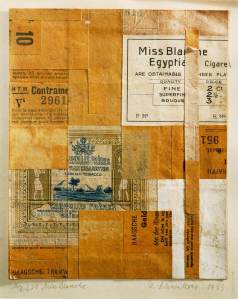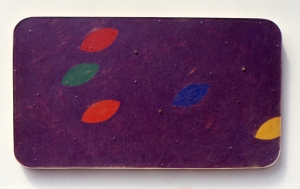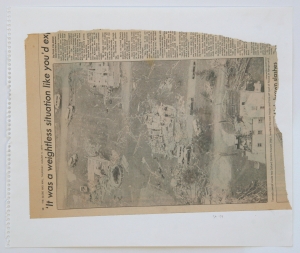
I’ve just discovered an interesting artist, Alan Uglow, thanks to an article by Gregory Williams in The Brooklyn Rail (Image courtesy of Brooklyn Rail) The painting on the right is from 1994, the serigraph “portrait” of the painting is from 2000.
This was going to be about Uglow and me and possibly Gerhard Richter and how copying your own work is a way forward from appropriation, the arbitrariness of subject matter, and the general flatness of everything. Then I got upset.
The problem started when I searched for Sherrie Levine to confirm she was the one who did rephotographing. That’s when I stumbled on this painting of hers, part of a series completed between 1987 and 2002. This particular one is from 1988.
So why am I upset?
I made these two plywood knot paintings in 1993, and called them The Things at the Edge of the Universe 1 and 2, 45″ x 50″ and 15″ x 26″.
So of course they have something to do with appropriation and how it is related to the difficulty deciding on subject matter when all things seem equal. They are ‘found’ compositions to some extent. All I had to do was colour them in.
We’re living on a very smooth plain, it’s difficult to find things sticking up enough to warrant sincere attention. This also has a bearing on attitudes to copyright, which is the reason everything I publish has been under

This work is licensed under a Creative Commons Attribution 3.0 Unported License.
But there is more. These two paintings are not just about appropriation, the lack of reasons and commitments, and the act of choosing itself. The latter two were well covered by Warhol and Duchamp respectively. The first one, appropriation art, is mainly a rehash of Warhol and Duchamp’s ideas taken to their end point. When youthful spite subsides, it’s time to respect your tradition. That’s the only way to change it. (T. S. Eliot, more or less.)
These two paintings have rounded corners, mildly suggestive of cathode ray tubes, what TV’s looked like in 1993. They are covered in very scratched quarter-inch plexiglass which elevates visibility to a second simultaneous picture plane. The plexiglass has a gridded array of holes drilled in it for finishing nails and the occasional screw. The grid is not square with the sides of the work, which gives the grid some tilt, but no vanishing point.
The nails hold the layers together, but they are also visible objects that travel through all the virtual objects generated with paint and scratches. Nails as wormholes perhaps, the things at the edge of the universe maybe – and all along we thought it was the painted knots. “Ha ha”, as Bosse-de-Nage the dog faced baboon would say. (Please refer to Alfred Jarry’s Exploits and Opinions of Dr. Faustroll, Pataphysician).
For the most part I don’t mind obscurity, but there are times when it’s frustrating. Frustrating because I feel compelled to defend and explain my work when I come across things that look quite similar – plywood knot paintings for example. But as Mosheim apparently said, “Renown is a source of toil and sorrow; obscurity is a source of happiness” [I got this from J. W. Von Goethe, Conversations with Eckermann (Washington and London: M. Walter Dunne, 1901), p. 6. And I have no idea who Mosheim is.]
Thankfully, I think it’s possible to feel schadenfreude for my own misfortune. Grimly satisfying wound licking isn’t half bad. While flattering myself that my work measures up to his, I can easily imagine myself in the circumstances of Kurt Schwitters. He said we shouldn’t worry about his obscurity and poverty because he knew very well how important he was. And he is important – his shadow continues to grow, just as Picasso’s shrinks. Therefore, I will not be bothered by the fact that I seem to have made a career of being overlooked and underestimated.

http://www.wikipaintings.org/en/kurt-schwitters/mz-231-miss-blanche-1923
1923 – and it contains seeds of almost all the ‘retinal’ art that follows. (“Retinal” is a reference to Duchamp’s pejorative term for all art that isn’t ‘conceptual’, for lack of a better word. It seems to me though, that visual art would use a retinal vehicle.) And looking at this one humble collage from 1923, I know I have a lot of work to do. The insidious influence of theory still drives me, I’m not retinal enough.
Sherrie Levine has made her career as an “appropriation artist”. She came to my attention in 1980 when she rephotographed pictures by Walker Evans and showed them as her own. It was a brilliant choice because Evans was such a damned earnest photographer, living in a time when artists really thought they were making a difference (aesthetic, political or both) – Schwitters, John Heartfield, Rodchenko, and so on. Levine’s move was a refreshingly bitter thing to do.
I’m sympathetic with appropriation, and in the 1970’s I tried my hand at it with a series of one-piece collages. From time to time, from 1976 to 1999, I tore things from newspapers, magazines, brochures, and maps that appealed to me, mounted them and signed them. These two are both coincidentally from 1979. I picked them because they look nice on my computer screen.
Seeing that map once again makes me think it would make a great painting – a little bit of a Richard Diebenkorn Ocean Park Series thing going on.

From http://en.wikipedia.org/wiki/File:Richard_Diebenkorn%27s_painting_%27Ocean_Park_No.129%27.jpg
My use of appropriation was sour grapes and cleverness to some extent, but it still had a hint of vicarious escape from media saturation in it. I took back the initiative, the choosing, I was less of a passive consumer. That was the do-good, Schwitters part, but that’s hardly adequate.
Appropriation is basically a rehash of Conceptual and Pop art. It is the blindingly obvious thing to do after Duchamp and Warhol. It’s also a one-trick pony to establish an art career – but if you keep doing the same thing for long enough, you’ll probably get famous. Morris Lewis demonstrated it and General Idea satirized it. As far as appropriation goes, I couldn’t be bothered with anything more than some scrap booking – there are so many other things to think about.
So much for being vexed, and onto the matter of copying your own work. I have three rules for art making: It needs charm, it acknowledges its roots in a tradition, and it contains some other idea, hopefully a new way to see or understand something. That’s a tall order, and I know I don’t always succeed.
In 1977 I propped a book on the arm of a chair. It was open to a photograph of Marcel Duchamp taken by Alfred Stieglitz and I photographed it. I then signed and dated the photo. If art were physics, then Duchamp’s Law would be, “The art of a thing is the choice.” I chose Stieglitz’s photo to be my art.
Levine’s photos of Evan’s photos are more pointed – they’re just the photos with no surrounding context, they’re about appropriation, pure and simple. My photo is polluted with context: the image, the book and the chair in my living room – frames within frames. Besides appropriation, it’s also about my sense of being on the outside, looking through a window into the art world, like watching a family dinner while standing in the snow. Art students sometimes feel that way, very Dickens.

I also enjoyed signing the front – photographers rarely do that.
I 2000, I photographed my photograph and printed it on enough paper to write a screed. It was intended to be amusing like my Artist Statement from a previous post.
It says, “I don’t think Jeff Koons and Sherrie Levine are Postmodernists. I see them as Academic Modernists, Duchamp’s epigoni reworking the readymade concept ad nauseum. My student work of 1977 reflects the same concerns: I accepted what I was taught about permissible museum-grade transgression. To a certain extent, Modernism seems to have been about the quiddity of art itself. Assuming this problem has been solved, and as far as I know, it hasn’t, the next logical step is the quiddity of quiddity. Unfortunately this issue is extremely abstract, and artists are better applied than theoretical philosophers. Instead, let’s suppose for a moment that some point would be served if we were to force historical facts into a dialectical process. This granted, the next dialectical step is to reconsider the ideas negated by Modernism. Notwithstanding De Stijl and Earthworks, (because historical facts must be carefully chosen) the negated ideas are the Beautiful and the Sublime. The other next dialectical step is to chose the particulars of Modernism which need to be negated. Let these be transgression and the logical model of art practice. Therefore, I am pleased to announce that my dialectical thinking has discovered the possibility of a post Modernism. It only lacks a name.”
This definitely illustrates that I had developed some hostility towards theory.
Not much more to say. Here are three related works:










Yes…Though I travel along like a shark, always moving lest I die, it still troubles me when I see work that resembles work that even I have left behind…Though I see now, that God pushed me along past that style, knowing there was a girl in India who was also painting in oils with her hands, & unfortunately, she began before I did, though I did not know that when I was doing them…(Also I wore surgical gloves to tap my fingerprints in, while she bravely bared her flesh…Which made her more dangerous…)
So you learn to keep innovating & evolving & working & just being brilliant…Eventually you find a cave on the top of a mountain that nobody else could possibly reach & that is where you can finally rest…A niche…A nest…
Your writing is brilliant…The words flow & nuggets like blueberries appear…Thanks for that…I don’t think anyone else will be able to steal your ability there…
LikeLike
Thanks for the high praise. I work hard to try to write well. Interesting thing: I have also painted in oils with my bare hands. Sometimes surgical gloves were used, but the final touches always needed those fine lines like an etching from my palms and fingers.
LikeLike
Thank you Steve for your blog posts, which I always enjoy reading… they engage both my brain and heart. You have the knowledge to back the ideas you put forth, and a sense of humor in recognizing the sinkholes that one might fall into along the creative path, or any path for that matter. Your three rules to art making I agree are challenging, but I would think meaningful if achieved. Engaging “retinal” understanding in how we view and what we see in the world is a way that can situate one in a particular place and time. “Escaping from media saturation” is not easy in a world increasingly governed by the volume and speed of information. Yet, we all need reasons to get up in the morning.
Let all us know when you reach the summit… I would like to visit.
LikeLike
Thanks for such generous praise. My ambitions are probably quixotic, but I can’t help myself – anything else would be boring.
LikeLike
Thanks – I find this extremely interesting as I was not aware of appropriation art as a genre. Writing – that artistically – about these photos of photos is probably taking it to the next level!
I wonder if somebody has already taken it to the extreme – such as taking photos of photos of photos etc.? Like the infinite regress of nested mirror images you see when you stand between two mirrors facing each other?
LikeLike
Copies of copies have been done, mostly, I suppose, to produce an accidental image due to the degradation. More interesting is Michael Snow’s photos of photos on a mirror.
http://www.google.ca/imgres?imgurl=http://www.gallery.ca/cybermuse/servlet/imageserver%3Fsrc%3DWI77852%26ext%3Dx.jpg&imgrefurl=http://www.gallery.ca/cybermuse/teachers/plans/zoomMTA_e.jsp?mkey%3D7852%26img_type%3DWI&h=640&w=522&sz=59&tbnid=vcd8JR81_sshHM:&tbnh=90&tbnw=73&zoom=1&usg=__efbm8vfh-PQXEXNumSJYTLOMqVE=&docid=80F9Gn6SqmlboM&sa=X&ei=NJs4UrTFE4q5qAHF5YGIDw&ved=0CC4Q9QEwAA&dur=4068
LikeLike
Thanks – intriguing indeed!
LikeLike
Brilliant article. I love the illustrations that you seem to effortlessly put in.
I believe obscurity is a source of happiness, my own as well as others. So much so that I know about Goethes conversations with Eckermann. Perhaps it’s better to look at it this way, than to bravely hold out for recognition after death (Schopenhauer, Nietzsche). I could never see the point in that.
LikeLike
[…] awkwardly misplaced to promote it here, as I consider this blog to be mostly about finding ways to write about art, I’m going to promote it anyway. This is a whole new thing for me, and it’s […]
LikeLike